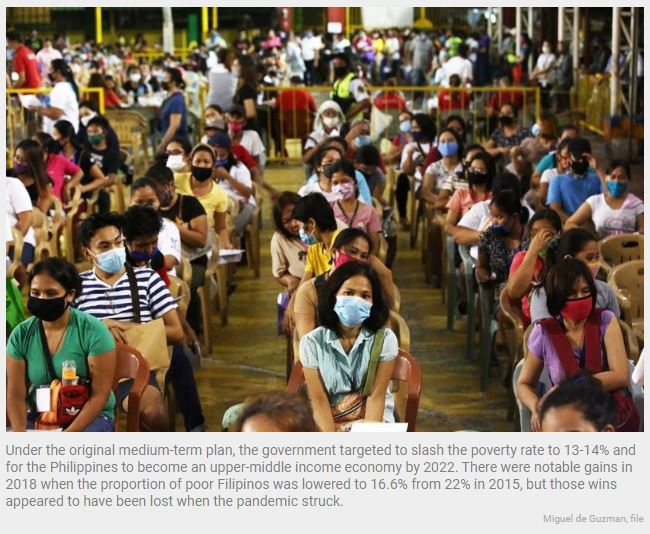Pandemic pulls more Filipinos back to poverty in 2021
MANILA, Philippines — More Filipinos ended poor in 2021 compared to three years ago after the pandemic wiped out gains in poverty reduction that took years to achieve.
A survey of 165,029 families nationwide showed there were 19.99 million Filipinos living below the poverty line last year, up from 17.67 million recorded in the comparable period in 2018, the Philippine Statistics Authority reported Monday. Poverty is measured every 3 years.
This translated to a poverty rate among the country’s population of 18.1% last year, higher than 16.6% rate posted in 2018.
The latest data indicates that the Duterte administration ended its six-year term missing its watered-down poverty reduction goal for its final year in 2022, when a poverty reading will not be conducted. Economic growth rebounded to 5.7% year-on-year in 2021 from a historic crash in 2020.
The previous administration originally hoped to cut the poverty rate by 13-14% this year for the Philippines to become an upper-middle income economy. There were notable gains in 2018 when the proportion of poor Filipinos was lowered from 22% in 2015, but those wins appeared to have been lost when the pandemic struck.This prompted the government at the time to temper that goal: to reduce the poverty rate to 15-17.5% this year.
Meanwhile the Marcos Jr. administration wants to cut poverty rate to 9% in its final year in 2028. To do this, the government is targeting to slash the current poverty rate by 5 percentage points by midterm of the nascent government.
“The effects of the COVID-19 pandemic, including income and employment losses, caused the poverty incidence to rise,” Socioeconomic Planning Secretary Arsenio Balisacan told a press conference.
“Restrictions on mobility and low earning capacity of poor households due to limited access to regular and productive jobs made the lives of Filipinos difficult,” he added.
Sought for comment, Sonny Africa, executive director of nonprofit IBON Foundation, said that the latest outturn should be no reason for complacent governance.
“The official poverty results may be taken as showing trends among the extremely poor Filipinos but it is oblivious to the continued distress of millions more families made invisible by being above the low official poverty line,” Africa said in a Viber message ahead of the data release.
Inflation threat
Data broken down showed a softer pace of increase in mean per capita income within a three-year basis. PSA data showed incomes from 2018-2021 only grew 3.8% as opposed to a 20.9% outturn in the previous releases.
For National Statistician Claire Dennis Mapa, the drop in per capita income was due in part to significant declines in sources of household income. According to Mapa, the drop came from entrepreneurial activities, which was reduced P133 billion, and the reduction of cash remittances from overseas Filipinos by P162 billion amid repatriations at the height of the health crisis.
Likewise, inflation will worsen poverty incidence, as Balisacan sees it. Inflation rose to 6.4% year-on-year in July, averaging 4.7%, on the back of expensive fuel prices and a weak peso.
“The effects of inflation last year could have negative effects on poverty yet what we saw in the data is that income inequality actually declined,” he said.
For one, Balisacan said early on in the Duterte administration, he did not anticipate the faster growth of prices in consumer goods and services inundating the economy today. But the NEDA chief is anticipating lower poverty incidence this year despite inflation.
“It appears that opening up of the economy that started last year particularly in the second half of 2021, appeared to have favorably affected the low-income groups. That’s quite interesting,” Balisacan added.
Aside from inflation, Nicholas Antonio Mapa, senior economist of ING Bank in Manila, said piling on poverty incidence was a slower growth momentum.
“Faster inflation and slowing growth momentum could translate to increased poverty incidence in the near term,” he said in a Viber message.
Data also showed that a family of five knee-deep in poverty would spend P8,379 on average for food in a month in 2021. This was higher by 10.94% compared to 2018 figures.
“The scars of the pandemic continue to show despite the recent string of positive growth highlighting the fact that the economy is and was in need of support post covid 19 lockdowns,” ING Bank’s Mapa added.
By region, Metro Manila had the lowest poverty incidence in the country at 2.2% last year, this was still higher than 1.4% recorded in 2018. Poverty in the Bangsamoro Autonomous Region in Muslim Mindanao was the worst at 29.8% rate, but this was a significant decline than the 54.2% registered in 2018.
Despite the gloomy figures, the Marcos Jr. administration is more than convinced it could reach its poverty reduction target. The national government is banking on the economic reopening earlier this year and better employment opportunities, among other things, to uplift the quality of lives.
To hit their goal, Balisacan said they want to trim the poverty rate by five percentage points midway of the Marcos Jr. administration, then cut it by four percentage points in the remaining years of the term tto hit their target. But Domini Velasquez, chief economist of China Banking Corp., noted their single-digit goal seems unattainable for now.
“Although we fully support the government’s target in reducing poverty incidence to 9%, this still seems unreachable without transformative reforms. A whole-of-society approach, the government and the private sector, in steering the economy to a high growth path should increase the chances in lifting most Filipinos out of poverty,” she said in a Viber message.
For Velasquez, the Marcos Jr. administration could focus on other targets for the meantime. “Improving Filipinos’ lives and getting more people out of poverty should be the number one priority of the Marcos administration. Providing more jobs, mitigating the rise in inflation, providing targeted subsidies to the poorest of the poor should be the near-term game plan,” she added.
Source: https://www.philstar.com/business/2022/08/15/2202777/pandemic-pulls-more-filipinos-back-poverty-2021


 Thailand
Thailand




